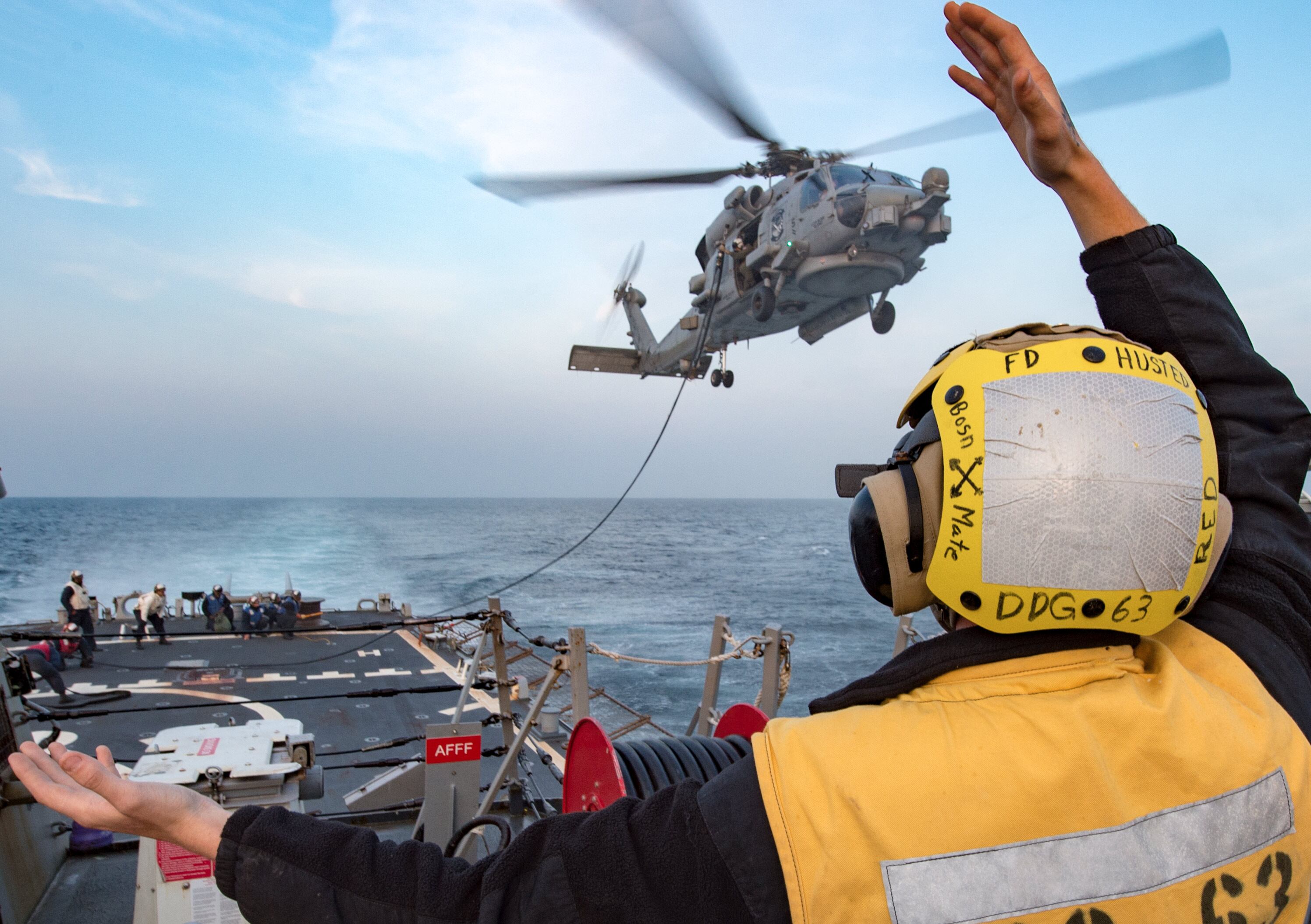More than a year after his disappearance, the death of Lt. Steven D. Hopkins remains a mystery.
The chief engineer never showed up for his watch training on the bridge of the destroyer Stethem shortly after midnight on Aug. 1, 2017, as the warship sailed the South China Sea during exercises with Japanese forces.
Several shipmates would report seeing him in various parts of the vessel between 2 a.m. and 6 a.m., and a search began that morning when the 30-year-old father of two failed to show up for a meeting.
One sailor was “80 percent certain” it was Hopkins seen topside at about 6:20 a.m. that morning, according to a copy of the military’s investigation into his disappearance following a Freedom of Information Act request.
The day before, Hopkins was seen taking a 35-pound kettlebell and a yoga mat from a ship gym.
RELATED

A mat and Hopkins’ glasses — unfolded, facing the sea — were found on the ship’s weather deck, pointing to a possible exercise mishap that toppled him into the sea.
Investigators never located the kettlebell.
But they also never found a backpack that had been in Hopkins' room. Hopkins’ internet history also showed a recent search on Robin Williams, the iconic comedian who killed himself in 2014.
Relatives insisted investigators that Hopkins was not suicidal. He got seasick and “would often go topside for fresh air to alleviate the symptoms,” they said.
Hopkins was declared dead a few days later, after American and Japanese crews had combed 16,155 square-miles of water looking for him. Both nations called off the search on Aug. 4, 2017.
Navy investigators concluded there was no evidence that someone else played a role in Hopkins’ disappearance.
Whether the chief engineer, or CHENG, may have fallen overboard or intentionally threw himself into the water remains unclear.
“There is not clear and convincing evidence of how LT Hopkins went missing,” the lead investigator wrote.
RELATED

Another investigator wrote that it was “highly likely LT Hopkins removed himself from the Ship" on purpose, however: “I think he attempted to make his removal look accidental by staging his glasses and workout mat on the flight deck."
Accidental deaths and suicides are both considered to have occurred in the line of duty and are not attributed to member misconduct under Navy regulations.
Life in the 7th Fleet
Hopkins’ death last year marked another tragedy in a grim summer for the Navy’s 7th Fleet.
The heavily redacted report into his disappearance does not imply that life in the Japan-based fleet played a role in Hopkins death. But investigators noted that like many surface warfare sailors in the fleet’s forward-deployed warships, Hopkins often failed to snatch enough sleep, was under great stress and worked hard to adapt to the operational tempo of a demanding job in a potential conflict zone.
He joined the crew of the Stethem on July 14, 2017, roughly a month after seven sailors drowned aboard the sister destroyer Fitzgerald following a collision with a merchant vessel.
Ten more sailors would perish on Aug. 21 when another Arleigh Burke-class destroyer, the John S. McCain, collided with an oil tanker near Singapore.
The probes into those mishaps eerily echo concerns raised by Hopkins' fellow sailors in the wake of his disappearance.
RELATED

Regardless of the cause of his death, the report indicates Hopkins was a well-liked and respected officer.
“LT Hopkins was described by much of the crew as quiet, busy, motivated, and friendly, with good morale and a good relationship with the CO and XO,” according to the final report.
One commander told investigators that Hopkins “was drinking from a fire hose,” but that he had been impressed with the young officer’s performance as CHENG.
Hopkins “was absorbed in his job,” yet didn’t micromanage his team when it came to night orders and other directions, another lieutenant told investigators.
Hopkins also was “getting into everything" and "would crawl through stacks, fan rooms, bilges, and get through the whole plant,” the officer added.
When Hopkins failed to show up for his midnight to 7 a.m. watch training on the day he went missing, shipmates assumed he was handling his CHENG duties.
RELATED

Earlier in his career, Hopkins served aboard the destroyer Ramage and the cruiser Normandy. The Texas man pinned on lieutenant in 2013, four years after receiving his commission.
Hopkins moved to Japan with his wife and two sons after the Navy promised him a spot promotion to lieutenant commander, according to the report.
At the time of his disappearance, however, his permanent promotion had not been granted.
Hopkins had a lieutenant commander’s uniform and even a coffee mug ready and he was frustrated, according to the report.

Shortly before he went missing, Hopkins emailed his wife “expressing uncertainty about his job and uncertainty about relocating from Norfolk to Japan,” investigators wrote.
A search of Hopkins’ internet history in the days before his death revealed “numerous searches on jobs outside the Navy, ways to get fired, how to explain getting fired, instructions … on resigning from the Navy, re-designating” and similar subjects, according to the report.
But two unnamed superiors with the rank of commander told investigators they never heard Hopkins discuss resigning his commission.
One commander said Hopkins was concerned about leading his department, but the senior officer told him the worries were normal and that he would be fine, according to the report.
At a department head meeting the afternoon before Hopkins went missing, however, “he reportedly appeared distracted, as if he had something on his mind,” investigators wrote.

The final opinions and recommendations of investigators were redacted in the copy of the report provided to Navy Times.
Hopkins’ mother-in-law, Eileen Lehman, was quoted as saying he was a “good man” and a “great father” in the Evening Tribune newspaper of Hornell, New York, shortly after Hopkins’ death.
“She doesn’t have anything to bring home … just a bunch of memories,” Lehman said of her daughter. “It’s a big ocean.”
Geoff is the managing editor of Military Times, but he still loves writing stories. He covered Iraq and Afghanistan extensively and was a reporter at the Chicago Tribune. He welcomes any and all kinds of tips at geoffz@militarytimes.com.





